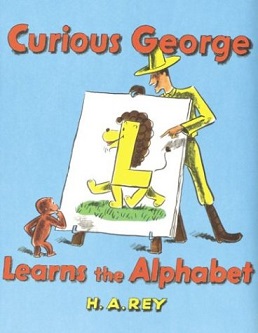Curious George Learns the Alphabet facts for kids

First edition
|
|
| Author | H. A. Rey Margret Rey |
|---|---|
| Country | United States |
| Language | English |
| Series | Curious George |
| Genre | Children's literature |
| Publisher | Houghton Mifflin |
|
Publication date
|
1963 |
| Media type | |
| Preceded by | Curious George Flies a Kite |
| Followed by | Curious George Goes to the Hospital |
Curious George Learns the Alphabet is a fun children's book. It was written and illustrated by Margret Rey and H. A. Rey. Houghton Mifflin published it in 1963. This book is the sixth story in the original Curious George series. In this adventure, George, the curious monkey, learns all about the alphabet with the help of the Man with the Yellow Hat.
Contents
George Discovers the Alphabet
The story begins with George's usual curiosity. He sees the marks in the Man with the Yellow Hat's books. George starts tearing pages, trying to figure out what's inside. The Man comes home just in time. He scolds George for tearing his books. He explains that books are for reading. They are full of stories, made of words, which are made of letters.
The Man then decides it's time to teach George. He wants George to learn the twenty-six letters of the alphabet. This way, George can understand words and even read stories. He sets up a pad and starts writing each letter.
Learning Letters and Pictures
As they learn, the Man and George write each capital and lowercase letter. Then they draw a picture that matches the letter.
- A is for ALLIGATOR and apple: The big "A" looks like an alligator's open mouth. The small "a" looks like an apple slice.
- B is for BIRD and bumblebee: George learns to stay away from bumblebees.
- C is for CRAB: A big crab looks like a big "C". A small crab looks like a small "c".
After learning the first three letters (A, B, C), the Man reviews them. He shows George how to make the word "cab." He even draws a picture of a cab. This is the first real word George learns!
More Letters and George's First Trick
Next, they move on to letters D through G.
- D is for DINOSAUR and dromedary.
- E is for ELEPHANT and ear.
- F is for FIREMAN and flower: The Man reminds George not to fool the fire department.
- G is for GOOSE and GEORGE: It's also for goldfish.
For their second review, the Man asks George to read new words. These words use the first seven letters (A through G). Words like "Dad," "Ed," "bag," "cage," "bed," "feed," and "bad" appear. While the Man gets lunch, George reads the words. But then, George gets an idea. He dances around the room wearing the alphabet chart like a cape! The Man is impressed George read the words. However, he scolds George for tearing the chart. He says George was "bad." Snack time is postponed until later.
Halfway Through the Alphabet
After lunch and a nap, they continue with letters H through M.
- H is for HOUSE and horse.
- I is for ICICLE and iguana.
- J is for JAGUAR and jack-in-the-box: Did you know jaguars live in South America? George met them in the jungle, but he was caught in Africa, where leopards live!
- K is for KANGAROO and kid kangaroo.
- L is for LION and lean lady.
- M is for MAILMAN and mouse.
The Man tells George that "M" is the 13th letter. This means they are halfway through the alphabet! For the third review, George writes words using the first 13 letters. The Man is happy with real words like "ball," "milk," and "cake." But George also makes up words like "dalg" and "blimlimlim." The Man explains that not just any letters make a word.
Playing and More Letters
They continue with letters N through T.
- N is for NAPKIN and nose.
- O is for OSTRICH.
- P is for PENGUIN.
- Q is for QUAIL and quarterback: The Man and George even go outside to play football!
- R is for RABBIT and rooster.
- S is for SNAIL.
- T is for TABLE and TEA: George prefers toast.
George's Big Donut Trick
They have now learned 20 letters, up to "T." For their fourth review, it's snack time. The Man gives George a note to buy one dozen (12) doughnuts. He adds, "And no tricks, please!"
But George, being curious, wants more. He crosses out "one" and writes "ten" above it. Now the note says "ten dozen donuts"! He goes to the bakery and hands the baker the note. The baker is surprised but gives George ten dozen (120) donuts in an extra-large bag.
When George gets home, the Man is shocked. George dumps all 120 donuts onto the floor! The Man sees the "revised" note. He scolds George for changing the note and making a mess. He reminds George he said "no tricks!" Snack time is postponed again until they finish the alphabet.
Finishing the Alphabet
Finally, they learn the last letters, U through Z.
- U is for UMBRELLA.
- V is for VALENTINE.
- W is for WHISKERS.
- X is for X-MAS: The Man explains few words start with "X."
- Y is for YAK.
- Z is for ZEBRA.
The Man tells George that "Z" is the very last letter. Now George knows all twenty-six letters! As a reward, the Man lets George have the donuts. On the last page, George uses most of the 120 donuts to spell out "THE END."

